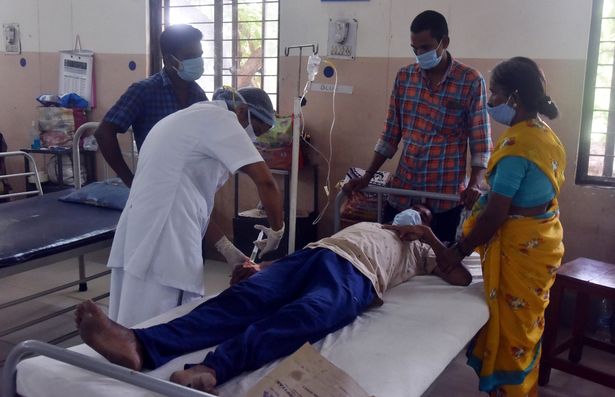Inside India’s ‘black fungus’ epidemic as cases hit 9,000 and patients have eyes removed – World News
As India battles the storm of the coronavirus pandemic a rapid rise of a fungus infection is causing patients to need their eyes removing in a desperate bid to save their lives.
A rapid rise in cases of mucormycosis, also known as black fungus, has added to the challenges already facing India’s healthcare system as it deals with a huge second wave of coronavirus infections.
More than 9,000 people in India have been diagnosed with black fungus and cases are still on the rise.
Thousands of Covid patients in India have had their eyes removed as a result of contracting black fungus as doctors believe the outbreak is being triggered by steroids being used to treat severe coronavirus.

(Image: Xinhua/REX/Shutterstock)
What is black fungus?
Black fungus or mucormycosis is a fungal infection that causes blackening or discolouration over the nose, blurred or double vision, chest pain, breathing difficulties and coughing blood.
The disease has a close link to diabetes, and conditions which compromise the immune system. Experts have said that an overuse during the coronavirus pandemic of certain drugs which suppress the immune system could be causing the surge.
Mucormycosis has a mortality rate of 54%, data from the USA’s Centres for Disease Control and Prevention shows.
Symptoms include blackening or discolouration over the nose, blurred or double vision, chest pain, breathing difficulties and coughing blood.
Is it contagious?
The disease is not contagious, so it cannot spread from contact between humans or animals, but it does spread from fungal spores that are present in the air or in the environment, which are almost impossible to avoid.
“Bacteria and fungi are present in our bodies already, but they are kept in check by the body’s immune system,” said K Bhujang Shetty, head of Narayana Nethralaya a specialty eye hospital.
“When the immune system goes down because of cancer treatment, diabetes or use of steroids, then these organisms get an upper hand and they multiply.”
What is causing the outbreak?
Some experts say that unsanitary conditions could increase the risk of developing the infections.
“There is a lot of contamination in the pipes used for oxygen, the cylinders that are being used, the humidifiers used,” said Nishant Kumar, an ophthalmologist at Hinduja Hospital in Mumbai.

(Image: AFP via Getty Images)
“If you are immuno-suppressed, and you have been on these pipes and oxygens for a long period of time, then these infections get much more of an opportunity to get in.”
But opinion is divided on this point.
“Hospitals were dirty even before April. We need epidemiological studies to assess why these cases are rising now,” said S.P. Kalantri, senior doctor and researcher at the Mahatma Gandhi Institute of Medical Sciences in Maharashtra.
Why are Covid patients getting black fungus?
Coronavirus has been associated with a wide range of secondary bacterial and fungal infections, but experts say India’s second wave of Covid-19 has created a perfect environment for mucormycosis.
Low oxygen, diabetes, high iron levels, immuno-suppression, coupled with several other factors including prolonged hospitalisation with mechanical ventilators, creates an ideal milieu for contracting mucormycosis, researchers wrote in the journal Diabetes & Metabolic Syndrome: Clinical Research and Reviews.


